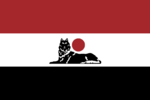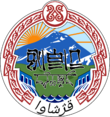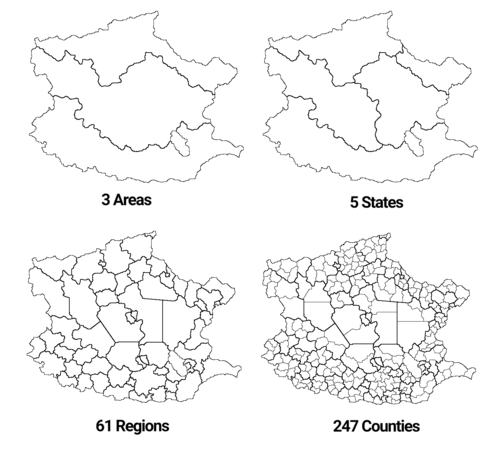Hondonia
The Duchrul of Qazhshava K'azhsharuliis Duchærulde | |
|---|---|
| Motto: "K'e Djaræmaru Ashey Dalænde Ghvoarul" "To Protect our Holy Homeland" | |
| Anthem: "Shanis Marshde" "March of the Mountain" | |
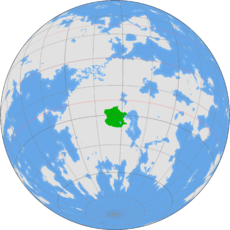 Location of Hondonia (green) in Thrismari (grey) | |
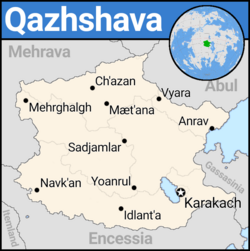 | |
| Capital | Karakach |
| Largest city | Yoanrul |
| Working language | Lakkathan (Qazhshavan) |
| Official languages |
|
| Demonym(s) | Qazhshavan Qash |
| Government | Federal Absolute Monarchy |
• Duch Duchæ | Kaid Yaghbarsdze Ghalvayu |
| Area | |
• Total | 992,650 km2 (383,260 sq mi) |
| Population | |
• 2018 estimate | 42,909,690 |
| GDP (PPP) | 2018 estimate |
• Total | 720.64 bn $ACU 1 441.29 ꞣ |
• Per capita | 17 000 $ACU 34 000 ꞣ |
| HDI (2018) | high |
| Currency | Kyærat ꞣ (QZK) |
| Time zone | -2 |
| Date format | dd-mm-yyyy |
| Driving side | right |
| Internet TLD | .qs |
The Duchrul of Qazhshava (Qash/Lakkathan: K'azhsharuliis Duchærulde ; IPA: /k'aʒ̊:aɾuli:s dutʃɤ̞ɾuldɛ/) is a country in the Anterian continent of Thrismari, it borders the Marmar sea to the east, the countries of Mehrava to the west, Encessia to the south, Gassasinia to the south-east, and the United Faerie Peoples to the north-weast, and Abul to the north. Qazhshava is in the MTCO (Midwestern Thrismari Cooperation Organization) linking Gassasinia with Mehrava and the rest of the MTCO.
The Capital, Karakach, is the second largest city in the country, after Yoanrul, it borders the biggest lake in the county, lake Lakot (Qash/Lakkathan: Tebza Lakot ), from which the two great rivers form, the rivers go through the entire country and all the way to Gorabo thorugh Mehrava.
Ethymology
The name Qazhshava comes from the word 'Qash' which comes from Ardugüd Qazh sha, who was the leader of the Qazhshavans when they migrated into the Ghodab desert (Qash/Lakkathan: Ghodabis Makod ) around the year 1160, the Mehrani people who he ruled over took the name Qazhshans, and the land he ruled became Qazhshava - mehrani for the land of Qazhshans
National Symbols
The Lakkalic Wolf (Qash/Lakkathan: Lak'alæn Vuwh ) is the National Mammal of Qazhshava, the symbolism originates with the Lakkalic people, who see the wolf as a great and sacred creature, and the embodimate of the god Warida, who is the highest diety of the Tjan'dza beliefes, even tho most Lakkalic people worship Islam or Christianity, major Tjan'dze followers still remain. Wolfs are still allowed to be hunted, but black wolfs are forbiden to kill, they are seen as the embodiment of Warida when she has serious buissness on earth and isn't playing around, it is believed that a person who killed a black wolf would be cursed with bad luck for the rest of their live.
The Snow leopard (Qash/Lakkathan: Yaghtjar , Barz ) is on the same rank as National Animal, but it isnt displayed as such. In Mehrani-Qash and Lakkalic beliefes the Snow Leopard is a sacred symbol. In Tjan'dze faith the Snow Leopard is seen as magical creatures symbolising power and agility, and it has served as symbols of Rish tribes for centuries.
The Golden Eagle (Qash/Lakkathan: Tjamæn Swah (rock(y) eagle)) is the Natoinal Bird of Qazhshava, it is both a Mehrani-Qash and Lakkalic Symbol, symbolizing a lot of diferent things, most overlaping wiht both cultures. In the Tjan'dze faith, it is seen as Atjama's (Godess of the Hunt) Pets.
Politics
The Duch Of Qazhshava
the current Duch of Qazhshava is Duchæ Kaid Ghalvayu.
Born in Voarsaghalæ, Lanshan region as Kaid Yaghbarzdze K'wenjashvi. Mother died in 1985, moved to Karakach. In 1989 joined the revolution with his father and overthrew the prefious Duchæ. 1995, his father died from poisson, he became the Duchæ and renamed himself to K. Y. Ghalvayu (coming from Xewxetan for "Great Wolf" - "ğală-vayũ" (/ɣalə‿ʋajũ/)). 1997 redraws the administrative map. ~ ~ ~.
Administration
The Administrative Divisions structure in Qazhshava goes as:
- The Duchrul
- Areas
- States
- Regions
- Counties
- Municipalities
- Cities/Towns/Villages
- Municipalities
- Counties
- Cities of Importance
- Mahlas
- Regions
- States
- Areas
Foreign relations
| Country/Union/Autonomous District | Status | State of relations | Mutual Embassies | Visa Requirement | Formal Relations Began | Qazhshavan Ambassador | Foreign Ambassador |
|---|---|---|---|---|---|---|---|
| Positive | Neighboring Nations, both in the Midwestern Thrismari Cooperation Organization. | Karakach/Jabiyah | No | 1949 | Boris Boaræshvi | Pierre Ghorayeb | |
| Very Positive | Neighboring Nations, both in the Midwestern Thrismari Cooperation Organization, and big historical ties. | Karakach/Azhtanan | No | 1987 | Mililyude Koarlardze | Razdân Razâqand | |
| Very Positive | Both in the Midwestern Thrismari Cooperation Organization, and historical ties. | Karakach/Al-Bashar | No | 1920 | Batr Tæghdze | Munsif al-Salloum | |
| Positive | Neighboring Nations, Big history, Lakkalic minorities in Encessia. | Karakach/Lonue | On arival | Batbayan Atiwashvi | |||
| Positive | Both are in the Midwestern Thrismari Cooperation Organization. | Karakach/Al-Zohrah | No | 1920 | Ian Mohamedshvi | Hakim Saidi | |
| Slightly Positive | Both are in the Midwestern Thrismari Cooperation Organization. | Karakach/Syropolis | No | Ali Tebzadze | |||
| Positive | Historical allies since the 1910s. | Karakach/Kentasi | On Arival | 1910 | Ýama Tushtoshvi | Elena Pejic |
Military
As of 2020, Qazhshava has an amry of 450 000 active-duty personel and 840 000 reserved on stand-by who can be deployed when needed. Equiped with 3 940 tanks (many of which are old models), 2 490 Infantry Fighting Vehicles, 6 220 Armored Personel Carriers, 1200 MRAPs (whit 50 more pre-ordered from ![]() Ateenia by 2021), x Artillery, 2 940 Air Defence Vehicles, along with 1 045 Combat Aircraft (including Helicopters), and a 107 strong navy (excluding river flotilla). The Qazhshavan Army is well-equiped and well-trained. Military spending of Qazhshava is about 3.9% of the GDP with a budget of 56,2 billion ghoshes (28,1 billion $ACU).
Ateenia by 2021), x Artillery, 2 940 Air Defence Vehicles, along with 1 045 Combat Aircraft (including Helicopters), and a 107 strong navy (excluding river flotilla). The Qazhshavan Army is well-equiped and well-trained. Military spending of Qazhshava is about 3.9% of the GDP with a budget of 56,2 billion ghoshes (28,1 billion $ACU).
The Qazhshavan Army is mostly active in the Zalistan and parts of the Aps'ana regions. A force is awlays kept ready for deploiment if needed .
Police
Demoghraphics
Demographic chart of Lakkatha (2018)
The mojority population of Qazhshava are Lakkathans, mainly living in and around the south, there are still a lot of acutal Mehrani Qash decended people, who are mainly populated throughoout the Ghodab desert, large concentration in the central ![]() Mehrava border, and throughout the desert itself, with the biggest concentrations being around the big cities and the capital Karakach.
Mehrava border, and throughout the desert itself, with the biggest concentrations being around the big cities and the capital Karakach.
The Lakkathans, who are the current majority in Qazhshava, are also the majority Lakkalic people, they are located mainly in the southern Mountains (majorities in ![]() Mehrava and
Mehrava and ![]() Encessia too), the capital of Lakkatha (a lakkathan authonomous region) is Idlant'a (the largest city in Qazhshava).
Encessia too), the capital of Lakkatha (a lakkathan authonomous region) is Idlant'a (the largest city in Qazhshava).
The Zali people are located thoughout the northwestern mountains (a large minority in ![]() Mehrava too). The Zal are a Lakkalic people who are related to the Lakkathans, and more closely the Aps'an, the Capital of Zalistan (an authonomous Zali region) in Ch'azan.
Mehrava too). The Zal are a Lakkalic people who are related to the Lakkathans, and more closely the Aps'an, the Capital of Zalistan (an authonomous Zali region) in Ch'azan.
The Aps'an are a lakkalic group living in the norhteastern mountains and coast, the Capital of Aps'ana (an authonomous Aps'an region) is Anrav.
The others cathegory is mainly Arabs from ![]() Gassasinia, Encessians and Mehranies, but it also has other Lakkalic people, like the Lavynne, Enlak, Kuch'kana, Lian, Holan, sofokli, Rish, Gudba, Nanuk, Lanshan, Didza, Miyn, and Meyv, who are generally live in small concentrated communities in the moutnains.
Gassasinia, Encessians and Mehranies, but it also has other Lakkalic people, like the Lavynne, Enlak, Kuch'kana, Lian, Holan, sofokli, Rish, Gudba, Nanuk, Lanshan, Didza, Miyn, and Meyv, who are generally live in small concentrated communities in the moutnains.
The Other Minority are the pre-Lakkallic pre-Qash Xewexetan people, who are the oldest people living in Qazhshava, they are located in the hills and fields neer lake Lakot.
| Group | Name |
|---|---|
| Lakkathan | Lakkatha, Enlak, Kuch'kana, Gudba, Sofokli, Miyn, Meyv |
| Zaloaps'an | Zal, Aps'an, Lavynne, Lian, Nanuk, Didza |
| Rish | Rish, Holan, Lanshan |
Geoghrapy
Culture
Language
The official language of Qazhshava is the Lakkathan (sumtimes internationally refered to as Qazhshavan) language (Qash/Lakkathan: Lak'ata menæ), which is the most spoken language of the Lakkalic language-gorup.
General B. Davadzshvi's speach (1912) in English, Lakkathan and Mehrani-Qash:
| English | Lakkathan | Mehrani-Qash |
|---|---|---|
| General B. Davadzshvi's speach: | Gheneral B. Dævædzshviis haymæde: | Zanêran B. Davadzshaviz shvid: |
| Stand up! | An! | Shandub! |
| Soldiers, we'll go inside the enemy trenches.
Once we're there, the ridge will defend us. |
Voayake, shay iýe ghemaru ænæ nwoarisde ok'ope.
Næsa shay aghe hwoa, haræbide iýe djaræw shey. |
Sazârs, vegâr anzad dâr anârmi jhen.
Onkve dêr, dâr ridze vil demêr ruz. |
| Forward means Freedom!
Stopping means Death! if we die, let's die like heroes! |
Tsæp'waredmide hæw Elave!
Zdamide hæw T'raghæ! Kwa shay t'aramaru, nay t'aramaru k'es Baghane! |
Favâd mâyn Farezâ!
Sartâpvi mâyn dâid! iv vedâi, lâdz dâi lâkh herêzar! |
| There are no two deaths, but it's impossible with none. | Armwæ twæ t'raghæbe, aw ej arak'eshts'a lewr ares. | Dêr âr nâr tôrdâid, bad êtz imjhanêvor vid nâra. |
| If you're afraid, Forward!
If you doubt, Forward! If you dont know what do to, Forward! |
Kwa ghre siærshænashre, tsæp'wared!
Kwa ghre sýanashre, tsæp'wared! Kwa ghre arzæshre k'o k'æ yæshre, tsæp'wared! |
Ivyâr afâd, Favâd!
Ivyur dousht, Favâd! Ivyur dunkhowsh vât todôr, Favâd! |
| When your bullets end, you have a bayonet.
If the bayonet breaks, you have hands! |
K'aa kurshumede she arawre, mwæshre shtik.
Kwa shtikde ghe shch'æw, mwæshre harwe! |
Venyôr buretz ind, yurhâv o bahjhâned.
Ivdâr bahjhâned bahrêkz, yurhâv handârz. |
| If your hands break, you have Theet! | Kwe harwe she ghe shch'æwre, mwæshre doaze! | Ivyôr handârz bahrêkz, yurhav tahiz! |
| Allah, and Qazhshava invoke us! | Allah, di K'azhsharuli mikaow shey! | Ala, ârd Qazhshavâ evâkh ruz! |
| Lakkalics, Yanarzar (Yoanrul) is infornt of us! | Lak'alibe, Yoanrul ej tsend shey! | Lakhâiz, Yanarzar iz infârâv ruz! |
| If we Win, Tuhrtsia will fall! | Kwa iýe halamaru, Tærts'ruli iýe chæræw! | Ivve vin, Tôhrajhan vil fahâl! |
Lakkalic
Mehrani-Qash
Xewexetan
Examples of Xewexetan Music:
Song of the Bison
Song of the horse
Sonf of the Spring
